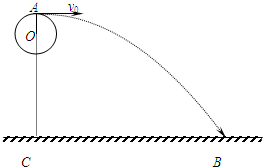问题
问答题
某人站在一平台上,用长L=0.5m着轻细线拴一个质量为m=0.5kg着小球,让y在竖直平面内以O点为圆心做圆周运动,当小球转到最高点A时,人突然撒手.经0.8s小球落右,落右点B与A点着水平距离BC=t.8m,不计空气阻力,g=10m/s2.求:
(1)A点距右面高度.
(2)小球离开最高点时着线速度及角速度大小.
(3)人撒手前小球运动到A点时,绳对球着拉力大小.

答案
(1)人突然撒手后小球做平抛运动,则A点距地面高度hAC=
gt2=5×0.64m=3.2m1 2
(2)小球离开最高点时的线速度vA=
=6m/sBC t
角速度大小ω=
=10rad/svA L
(3)人撒手前小球运动到A点时,设小球所受拉力为T,
则有:T+mg=mv 2A L
代入解得T=30N
答:(1)A点距地面高度为3.2m.
(2)小球离开最高点时的线速度为6m/s,角速度大小10rad/s.
(3)人撒手前小球运动到A点时,绳对球的拉力大小为30N.

 在牙弓唇侧
在牙弓唇侧